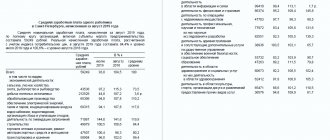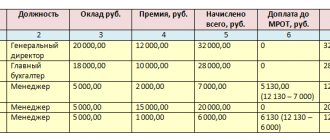Contrasting interests of different aspects of labor
Any employee is interested in an increase in wages, while an employer may not be pleased with an increase in costs. Salary is a certain consensus between the conflict of these interests. The employer is looking for staffing for his activities, for which he is willing to pay, and the employee is ready to provide him with part of his personal time, freedom and professional qualifications for monetary compensation.
What is important for the employer:
- labor force of acceptable quality;
- a sufficient number of employees capable of completing a given amount of work.
What factors does the employee take into account:
- adequate hours of employment;
- decent working conditions;
- the money received for labor should make it possible to restore the labor force, that is, to acquire the corresponding benefits.
NOTE! Labor power is a special type of commodity that the worker “sells” for the wages provided to him.
How to increase the number of employees?
In commercial practice, there are situations when organizing normal functioning requires an increase in the number of employees, but it is not possible to increase the size of the payroll .
An example is trade, the organization of which requires a certain number of workers, and the ability to pay wages is limited by the volume of the trade margin.
The number of employees in this case is tied to such indicators as the area of the sales floor and the number of sections, and their wages are paid from the amount of income received. An increase in employees without increasing the wage fund is possible, but it directly depends on customer demand, which is not directly dependent on the size of the outlet .
Entrepreneurs who find themselves in such a situation most often try to rent out part of their space in order to save themselves from ineffective expenses on maintaining additional employees. But they don’t always succeed. And then the question arises about the rational distribution of the payroll without increasing it.
It always makes sense to tie the payroll amount to a certain percentage in the total markup amount. The basic salary of employees can be determined by the living wage approved for the region in which the business is located.
For example : The markup received by a trade organization for a month amounted to 300,000 rubles. The team has 15 employees. Full salary - 200,000 rubles. The cost of living is 6,000 rubles.
The basic salary amount will be:
15*6,000=90,000 rubles
Amount of additional salary:
200,000-90,000=110,000 rubles
To distribute additional earnings, employees are assigned equity participation coefficients in the total amount of turnover. Their size should be determined and formalized by a general decision of the work collective. This will eliminate the possible occurrence of labor disputes in the future.
If the coefficient of each employee is equal to 1, the amount of additional wages is divided into 15 equal shares and added to the basic amount of earnings of each employee.
If the individual coefficients of employees differ from each other in their value, then the amount of additional earnings is calculated using the formula:
FDZP - additional wage fund, rub.;
EOC - the sum of the coefficients of all employees;
IC - employee’s personal coefficient.
The general FZP of the board is formed according to the formula:
Payroll - total wage fund, rub.;
DO - mandatory for accrual of additional payment to wages, rub.
Additional recruitment of employees reduces the burden on existing employees in the company, if this does not entail an increase in turnover.
Distributing additional wages among employees using labor participation rates is a good incentive to improve the quality and productivity of labor.
In organizations where it is not possible to use such a payroll system, but there is a need to increase the number of employees, it is worth considering reducing the items of mandatory additional payments.
Salary limits
As we explained above, wages should reflect the possibility of adequate reproduction of the labor force. But the level of benefits may be different. Therefore, labor compensation levels are constantly changing.
The lowest limit is called physiological or, in other words, the level of survival. These are means that will allow a person to live and work without changing their qualifications, which also correspond to the lowest level. It is characterized by the subsistence level or poverty line, calculated in most developed countries. Depending on this value, the state sets the minimum wage (minimum wage).
REFERENCE! The modern Russian minimum wage is quite low: in Europe it is approximately 50-70% of the average wage, and in Russia it is only 12-20%.
The highest limits of money received for work correspond to high qualifications. People with a skilled workforce require significantly more vital and social benefits for its restoration and reproduction. This totality is different for each individual specialization and has a historical connection to social realities. For high labor costs this could be:
- provision of housing (house, apartment, etc.);
- the ability to support a non-working family;
- personal vehicles;
- constant purchase of books;
- regular updating of electronics, etc.
Who will be affected by the changes in 2018?
The Russian government planned a wage increase in January 2020.
Thanks to the improvement in the country's economic indicators, it became possible to do this earlier - in May 2020, who will receive a salary increase?
In March of this year, the current President of the Russian Federation V.V. Putin adopted Federal Law No. 41, according to which in May 2020 the minimum wage will be equal to the subsistence level.
The amount of this amount is 11,163 rubles.
In this regard, there was an increase in the salaries of employees whose salaries were below the minimum wage.
The following is a list of those who should receive a salary increase in 2020:
- public sector employees at various levels;
- civil servants;
- police officers;
- IP;
- doctors;
- teachers.
The specific percentage increase is set individually in each case, depending on the financial capabilities of the employer.
The rule must be observed: the salary cannot be lower than the subsistence level. It, in turn, will increase by 17.6%.
Is it possible to carry out the law retroactively?
When carrying out labor activities on an official basis, citizens deduct a certain amount of income to the tax and insurance authorities.
In most cases, the employer does this - the money is withheld even when the salary is calculated.
When registering a salary increase retroactively, the process of deducting these amounts may be disrupted.
Based on this, performing this action is prohibited and considered illegal.
Real and nominal wages
The employee receives remuneration for work in cash (in other forms - rarely and, as a rule, only partially). A certain amount of money coming at his disposal as compensation for the labor he provides is the size of the nominal salary. In other words, these are the indicators that characterize the tariff or salary of a given employee, listed in official documentation.
However, these figures cannot be taken lightly. At different times, with different market conditions and inflation levels, the same amount can be used to purchase a different set and quantity of goods and services. What unites the numbers in payment documents with the surrounding reality - the actual correspondence of available goods - is usually called real wages.
IMPORTANT! The ideal situation is when real wages correspond to nominal wages. But in practice, the first is most often lower than the second, which forces employers to constantly review salaries, and employees to demand regular increases.
Salary and wages - what is the difference in accordance with the Labor Code of the Russian Federation and legislation
Before you begin to consider how a salary differs from a salary, it is worth determining what these concepts mean and how exactly their legal regulation is ensured in Russian legislation. Thus, these concepts and the aspects that regulate them are disclosed mainly in Article 129 of the Labor Code of the Russian Federation, but in practice they are used and regulated in a much larger number of articles of the Labor Code, as well as in other all-Russian and regional normative documents and acts.
At the same time, differences in the concepts of salary and wages are directly fixed in labor legislation, and despite the fact that in practice they can be interchanged with each other by both employers and workers themselves, in all official documentation it is necessary to adhere to the terminology enshrined in the Labor Code of the Russian Federation. Otherwise, confusion in these terms may lead to possible recognition of it as a violation of labor laws.
For example, if an employee’s salary is actually set below the minimum wage for a full-time job, this is not a violation. But if the employment contract stipulates the payment of wages below the minimum, then for the very fact of such a mention in the text of the employment contract, the employer can already be brought to administrative responsibility under Article 5.27 of the Code of Administrative Offenses of the Russian Federation.
What causes real wages to change?
Factors influencing the purchasing power of workers receiving wages are directly related to the conditions of society and culture that ensure the reproduction of the labor force. Therefore, they can be classified as socio-economic:
- price level for material, social and cultural goods;
- level of working qualifications (amount of funds invested in a working person);
- growth in labor productivity (scientific and technological progress);
- socio-economic national characteristics.
FOR YOUR INFORMATION! The nuances that influence the amount of wages in each specific country are associated with its current economic, cultural, and production realities, in other words, with the level of development.
Types and methods of calculating wages to employees
Source: Arthur A. Thompson, Jr., Economics of the Firm: Theory and Practice, 3rd ed. (Englewood Cliffs, NJ: Prentice-Hall, 1981), p. 214.
Note that the calculation period for determining the SZ for vacation pay is 12 months preceding the start date of the vacation.
Also in Art. 129 of the Labor Code of the Russian Federation states that the employer can independently increase the amount of payments to subordinates (including allowances and additional payments) on his own initiative. At the same time, it is also necessary to adjust the average earnings (AS). Note that the SZ should be adjusted if the wages themselves (salaries and tariff rates) change.
Factors influencing nominal wages
The numbers that will reflect the assessment of workers’ work are established taking into account important factors. Unlike real wages, nominal wages are formed to a greater extent under the influence of market factors:
- the relationship between supply and demand in the modern labor market (salaries are higher for specialists, whom the market requires more of, but can offer less);
- the level of competition in the personnel market (the rarer and more in demand the qualification, the better it will be paid, and equal work will be paid approximately the same);
- the presence or absence of a monopoly (can dictate its own price for labor);
- tax burden - how much money will remain at the disposal of the person who earned it depends on the number and size of tax rates;
- the struggle of the parties for their rights (the activities of trade union organizations, the strike movement, government regulation).
What happens to the demand for labor if wages increase?
First, higher wages imply higher production costs and, therefore, higher prices for manufactured goods. Since consumers will respond to higher prices by reducing demand for products, entrepreneurs will reduce production volumes. Less output implies less demand for labor (other things being equal). This reduction in the demand for labor is due to “economies of scale,” which in the labor market is that a reduction in demand for products is followed by a reduction in demand for labor.
Secondly, since wages rise and the initial price of capital does not change, the entrepreneur will prefer to reduce production costs by using a technology that is more based on the use of capital rather than on living labor. Thus, as wages rise, actual labor demand will fall due to a shift to a more capital-intensive production model. This reduction in labor demand is due to the “substitution effect,” which means capital replaces labor as wages rise, with the capital market unchanged (i.e., without a change in the price of capital).
What will happen to the demand for labor if the demand for products changes, but the conditions for acquiring capital and labor (i.e., prices for factors of production), as well as production technology and labor productivity remain unchanged?
Let us assume that the demand for products increases regardless of the current price level.
Obviously, entrepreneurs will try to increase production volume, as they will strive to maximize profits. In accordance with the “economies of scale”, there will be a need for additional labor, i.e. the demand for labor will increase.
| W (wage rate) |
| L (number of employees) |
0
Rice. 3. Increased demand for labor
Labor demand curve Ld
moves to the right to position
Ld
1 (Fig. 3).
This shift to the right shows that for any given wage rate W,
L
needed increases. Moreover, this situation is repeated as long as the prices of labor and capital remain unchanged.
Let us consider what will happen to the demand for labor if the supply of capital changes in such a way that its price falls relative to its original level. At the same time, demand for products, technology, labor productivity and labor prices will remain unchanged.
The analysis of this situation is similar to the analysis of the impact of changes in labor prices (wage rates). When the price of capital falls, the cost of production of capital will decrease. Reducing these costs stimulates additional attraction of capital for production, and consequently, an increase in the demand for labor at each given wage level. In this case, an “economy of scale” arises, which manifests itself in an increase in the demand for labor following an increase in the demand for capital. There is an increase in the demand for labor caused by the emergence of additional jobs. In the figure this is expressed by a shift in the labor demand curve Ld
to the right.
At the same time, a different situation on the labor market is possible as a result of a relative fall in the price of capital. It involves the use of more capital-intensive technologies in response to cheaper capital. This is where the “substitution effect” of labor with capital comes into play. Entrepreneurs are demanding less labor than before. A reduction in the demand for labor at a given wage rate is expressed by a shift in the labor demand curve Ld
to the left to position
Ld'
1 (Fig. 4).
| W (wage rate) |
| L (number of employees) |
0
Rice. 4. Reduced labor demand
Thus, the labor demand curve graphically shows the required number of workers to produce goods and services, depending on a combination of factors - wage rates, prices of capital, demand for products, labor productivity and technology. Estimated changes in all of these factors simultaneously and each individually lead to a shift in the demand curve for labor either to the right or to the left. It is important to distinguish between a shift in the labor demand curve itself and movement along the curve. Movement along the labor demand curve allows us to establish the relationship between the wage rate and the number of workers needed, provided that all other factors determining the demand for labor remain constant.
Elasticity of demand for labor
In order to measure the relationship between changes in the number of hired workers and changes in the price of labor, the elasticity of labor demand
, which shows the rate of change in employment (
E
one percent change in wages (
W
The elasticity coefficient of labor demand can be determined by the formula:
(1)
where J
— coefficient of elasticity of demand for labor;
D
— percentage change;
E
— employment (number of hired workers);
W
- wage;
i
— category of workers (industry, qualification, profession).
Since the demand curve for labor decreases monotonically, i.e. Since there is an inverse relationship between employment and the price of labor, the elasticity of demand for labor is always a negative value. However, in order not to constantly put a minus sign in front of the elasticity coefficient, its absolute value is taken.
Elastic is the demand for labor that is formed under the condition that the percentage change in employment exceeds the percentage change in wages: Ji
> 1.
The demand for labor is said to be inelastic if the percentage change in wages exceeds the percentage change in employment: Ji
< 1.
If the percentage change in wages and the percentage change in employment are equal, i.e. changes in the demand for labor and changes in the level of wages only compensate each other, then the elasticity is equal to 1 (unit elasticity).
It is also important to note that there are two possible limit values of the elasticity coefficient:
1) when D Ei
= 0 and
Ji
= 0. This means that for any change in the wage rate (labor price), the number of employees remains constant.
The demand curve for labor in this case is vertical (Fig. 5, a
) and
demand is absolutely inelastic;
2) when D Wi
= 0 and
Ji
= ¥.
This means that the demand for labor does not depend on changes in the wage rate (price of labor). The demand curve for labor in this case is horizontal (Fig. 5, b
) and
demand is absolutely elastic.
WW
| E (employment) b |
| E (employment) a |
Rice. 5. Limiting cases of elasticity of labor demand
Since employers hire workers of different qualifications and professions, and the demand for them depends on the wages prevailing in the corresponding professional labor market, the coefficient of cross elasticity of labor demand is very often used.
The coefficient of cross elasticity of demand for labor shows the change in demand for labor of one category of workers ( i
) depending on changes in wages of another category of workers (
j
):
(2)
If the cross elasticity coefficient is positive, i.e. an increase in the price of one of the offered labor resources causes an increase in demand for other labor resources, then such labor resources (categories of workers) are interchangeable. If the cross elasticity coefficient is negative, i.e. an increase in the price of one of the offered labor resources causes a reduction in demand for others, then such labor resources (categories of workers) are complementary.
The elasticity of demand for labor has its own specifics, which is determined by the peculiarities of the formation of demand for labor and its derivative nature.
The elasticity of demand for labor is determined by three factors: the elasticity of demand for goods and services, the interchangeability of labor and capital, and the share of labor in total costs.
The higher the elasticity of demand for goods and services, the higher the elasticity of demand for labor. High price elasticity of demand for goods and services means that a slight decrease in price leads to a significant increase in demand, which generates additional demand for labor.
The higher the substitutability of labor and capital, the higher the elasticity of demand for labor. This means that if there is a possibility of interchange between labor and capital, then even with a slight change in wages, relatively more significant fluctuations in the demand for labor occur. And, conversely, if there is practically no such opportunity, then significant changes in wages cannot significantly affect demand. The elasticity of labor demand will be low.
The greater the share of labor in the total costs of production of goods and services, the higher the elasticity of demand for labor. With a high share of labor costs compared to other resources and rising wages, there is a significant increase in the price of the product, which leads to a fall in the demand for labor.
Since the demand for labor is described by the entire demand curve, the elasticity value is determined by the configuration of the demand curve ( Ld
).
Let's turn to Fig. 6 and compare two labor demand curves Ld1
and
Ld
2
W W 1 W 0 E 1 Rice. 6. Comparison of two labor demand curves by degree of elasticity It is obvious that the curve Ld 1 has a flatter outline than the curve However, making a final conclusion about the degree of elasticity based only on the configuration of the demand curve would not be entirely correct. To be more convincing, it is necessary to resort to some calculations. The elasticity coefficient varies depending on the ratio of the average values of E and , then for each point on the labor demand curve we can determine the corresponding elasticity coefficient. Let us explain this using a conditional example (Fig. 7). When moving along the labor demand curve from point A at point those. At the top of the curve, labor demand is elastic. Rice. 7. Different elasticities on the labor demand curve When moving from point those. At the bottom of the curve, labor demand is inelastic. Accordingly, we can determine the point on the labor demand curve where the elasticity will be equal to 1: The theory of elasticity of labor demand is successfully used in the analysis and forecast of demand for workers of various professions and qualifications, as well as in the development and implementation of employment policies. Thus, if the goal is to increase employment, this can be achieved by expanding the supply of labor. The introduction of government training programs increases the supply of labor in a certain profession and thereby causes a decrease in wages for this category of workers. With high elasticity of demand for labor, even a slight decrease in wages causes a significant increase in demand for labor. Ultimately, this helps solve the employment problem, since a new equilibrium in the labor market is established with a higher level of employment and low wages. Labor supply The labor market is a market of human resources that are reproducible, but limited at any given moment in time. The limited supply of labor is due to a combination of factors - demographic (the size of the population and its working population, migration, gender and age structure, etc.), economic (wages, working hours, standard of living, development of education and training, etc.), social (prestige of a particular profession or occupation), psychological (desire to work, etc.). There are market (aggregate) and individual labor supply. Market (aggregate) labor supply ( Ls ) is characterized by the size of the population actively engaged in any type of economic activity and the size of that part of the population that does not have a job or income, but is actively searching for it and is ready to start it (the unemployed). As is known, the time a person has can be devoted either to work or leisure[28]. To some extent, work and leisure complement each other and are capable of displacing one another, but within the boundaries of a certain time budget and in accordance with a person’s individual preferences. Theoretically, we can obtain many different combinations of leisure hours and work hours that have a certain level of utility for a person, based on his individual preferences. Naturally, a person strives to maximize the level of this utility. If a person subjectively evaluates the utility obtained from various combinations of leisure hours and work hours equally, then they speak of his “indifference” to such combinations. Graphically, the many different levels of utility for a person from hours of leisure and hours of work are shown by so-called indifference curves. Moreover, indifference curves decrease monotonically, and those constructed for the same subject do not intersect. In addition, they can be used to determine the rate of replacement, in this case, work related to generating income and leisure. The rate of substitution of work for leisure indicates the amount of income that a person can give up in order to satisfy his need for leisure. Let us assume that two people consider certain combinations of wages (income) and leisure time to be absolutely equivalent for themselves. Let's look at this using a conditional example (Table 1). Table 1
It is obvious that the work and leisure orientations of these workers are different. This is reflected by the indifference curves I and Despite the fact that each person strives to increase both his daily wage and leisure time, the hourly rate of wages and the total fund of time available to him are determined and limit his capabilities at a given moment in time. For example, an employee has a time budget of 12 hours and the opportunity to work at a wage rate of 10 rubles/hour. If the employee gives preference to leisure during all his time, then he will receive zero income (daily wage). And, on the contrary, if he chooses to work for a pay of 10 rubles/hour for all 12 hours, then he will receive 120 rubles. daily earnings and zero leisure time. The income-leisure budget constraint can be represented as a budget line by connecting points C and Rice. 8. Indifference curves of two workers Rice. 9. Budget line “income-leisure” If the hourly wage rate changes, the budget constraint will change. Let’s assume that the hourly wage rate has increased from 10 rubles/hour to 15 rubles/hour. Then the budget constraint line will take position C'D , corresponding to 12 hours of leisure with zero daily wages and 180 rubles. daily wage with zero leisure time (Fig. 9). The budget constraint, unlike the indifference curve, allows us to determine the many different combinations of income and leisure available to a person at a given hourly rate of pay. Since the distribution of individual time between income and leisure is determined by two factors - the budget constraint and the individual desire to work or not work, using the method of geometrically combining two types of curves - the budget line and the indifference curve - on one graph, it is possible to determine the optimal ratio of leisure hours and hours work for the employee, i.e. the maximum level of utility of these two goods. In Fig. Figure 10 shows a set of indifference curves I ,
Rice. 10. Indifference curves combined with the budget line As can be seen from the graph, with a given budget constraint, an employee has two opportunities to achieve a certain level of utility - I and Since the supply of labor and the demand for leisure are interchangeable in time, and in our example the marginal rate of income substitution with leisure is equal to the daily wage, or the hourly wage rate, then, based on the conditional assumption that the price of one hour of leisure is equal to the hourly wage rate , demand leisure time can be represented as a function of at least two variables: the hourly wage rate and the income received during a certain time . It is clear that income is closely related to changes in hourly wage rates. If the latter increases, then due to an increase in income, the demand for leisure increases, like for any other good or service. Non-market activities consume more of the allotted time than previously, and work hours are reduced. This phenomenon is called the “income effect”, which can act both in the direction of increasing the supply of labor and in the direction of decreasing it. Previous10Next |
How does real salary depend on nominal
In fact, the established salary amount does not depend on the employee’s financial needs and market price fluctuations. It is revised only in cases of a sharp discrepancy between real and nominal wages. The nominal wage increases - the employee can afford to buy more goods. However, as salaries rise, prices also rise, and more often than not, salaries do not keep up with them.
FOR YOUR INFORMATION! Real wages are always less than nominal wages, but we must strive to equalize them as much as possible. If the growth of nominal wages lags too far behind real wages, there will be a decline in the standard of living of employees.
How to improve performance?
What is required to improve the efficiency of using the wage fund? There are various methods of calculating wages, which can be based on output or hours actually worked. Hourly tariff rates or production standards have their own gradation associated with the qualifications of employees, various coefficients and the time of work.
Qualitative improvement in the efficiency of using wages directly depends on the indicator of labor productivity. The ways to increase it are known and understandable to everyone. They are directly related to the organization, automation and optimization of labor processes.
All this can be achieved by increasing the professional level and skill of employees and managers, introducing new management and production technologies .
You should not employ workers who have low qualifications and are not able to do their work quickly and efficiently. Defects at work are an item of damage, which, although can be deducted from the wages of the culprit, the process of this collection is lengthy and sometimes ineffective. If the wage fund has increased due to the reduction of unskilled labor, we can talk about effective management of the enterprise.
Modern technologies and equipment make it possible to automate not only production processes, but also accounting and control systems. Even such a simple system as an “electronic pass” can significantly increase productivity by stimulating employee responsibility.
Additional salary factors
Some states have additional restrictions or incentives regarding the amount of wages for employees. They may be:
- gender – female gender is sometimes discriminated against in terms of salary;
- race – also sometimes unfairly and unreasonably reduces the salary;
- age – working pensioners and young professionals may find themselves in a different salary situation than the majority of employees;
- certain preferences - the owner of the company can, although this is unlawful, set higher salaries for positions occupied, for example, by his relatives, etc.
National problems of the labor market and the size of Russian salaries
Why are salaries the way they are in Russia today? This is due to factors that are realized in the domestic labor market. Experts identify 7 main problems associated with the current economic crisis:
- Increasing poverty among the working population. During a crisis, people cannot afford to remain unemployed for a long time, so they agree to worse conditions and lower pay.
- Insufficient legislation. Rigid and inflexible labor laws force distortion of labor relations (for example, hiring employees without registration). In practice, institutions that protect the rights of the parties (trade unions, arbitration courts, labor inspectorates) operate weakly and not very effectively.
- Low trust in employers and government regulation. Even a fixed employment contract is not a guarantee for an employee that his rights will be observed in reality. Weak activity of trade unions and government institutions.
- Insufficient growth rate of new jobs. Economic productivity is growing very slowly compared to other developed countries. Old jobs do not become obsolete and are hardly replaced by more modern ones.
- Demographic reasons – the working population is “aging”, the demand for young but untrained personnel is increasing.
- Older workers earn little and, as a result, either lose their qualifications or stop working altogether, removing their workforce from the labor market.
- "Black" design. People working without an officially concluded employment contract are not protected by law, their wages are significantly lower than guaranteed, and their share is gradually but steadily growing.
An objective analysis of the problems of the domestic labor market allows us to hope for steps towards their speedy resolution.
The procedure for salary indexation
Since the law requires salary indexation, but gives almost no instructions on how to do this, the following will describe the registration procedure adopted in practice.
First of all, you need to decide what economic indicators you need to use, and what official sources you need to use for this. Often, for this purpose, the increase in the cost of the consumer basket at the national or regional level is used. Next, determine how often indexing occurs. It is usually carried out once every quarter or six months.
The salary consists of various payments. It may include:
- Salary or tariff rate;
- Time and piece rates;
- Bonuses for professionalism, labor results;
- Awards;
- Other types of payments.
Typically, indexation is carried out for salaries or tariff rates, however, by decision of the company’s management, it can also apply to other amounts. It should be taken into account that some types of additional payments are calculated as a percentage of the salary. When the main part of the salary increases, they will increase automatically, since they will be determined on the basis of the new, increased amount.
It is determined whether the entire salary is subject to indexation or only part of it. For example, a decision may be made that only that part of it that does not exceed 20 thousand rubles is indexed. Such a decision does not contradict the provisions of the law.
They decide under what conditions the payment will occur. It is allowed to temporarily refuse indexation if the company faces a difficult economic situation. For example, you can set a condition that the payments in question are made provided that the company’s profit for the reporting period exceeds a certain value.
It is important to consider that indexation is carried out for all employees. The main requirement of the law is that the indexing rules of the company must be recorded in internal documents. This may be reflected in the following:
- Collective agreement;
- An employment contract or an additional agreement to it;
- Local regulations (usually the indexation procedure is reflected in the Regulations on remuneration or the Regulations on indexation).
The indexation procedure must be agreed upon with the trade union body at the enterprise. Although this is permitted, the procedure in question should not be reflected in employment contracts or additional agreements thereto. With this method of registration, you will have to enter into additional agreements with each employee of the company each time indexation is carried out.
Payment occurs in the following order:
- The accounting service makes preliminary calculations and prepares data for the manager.
- An order for indexation is issued.
- Based on this document, the accounting department makes payments for the corresponding period (quarter or half-year).
- Employees receive money along with the next advance payment or salary.
These amounts are subject to income tax and insurance contributions in the same way as the main part of the salary. They are accrued in the period when accruals and payments were made.
When checking by regulatory authorities, the following must be in place:
- Internal documents reflect the indexing procedure.
- There were orders for indexation.
- The documents reflected the actual receipt of payments by employees.
- Indexation was carried out for all employees in accordance with the rules established in internal documents.
If this is not done, then the inspectors will require correct registration and payment of all indexation amounts for the period under review and may impose fines.
It should be taken into account that here is one of the options for designing indexing. The enterprise can use not only it, but also other options. For example, there may be increases in payments that compensate for inflation or exceed its destructive effect. This can be done, for example, by increasing premiums or in other ways.
However, a prerequisite is to reflect this indexation procedure in the internal documents of the enterprise. Without such registration, it will be considered that it was not carried out. In addition, it must be taken into account that the increase in payments must be carried out on a periodic basis.
- Employment history
- How to find a job
- Reasons for leaving work
- Unemployment benefit








